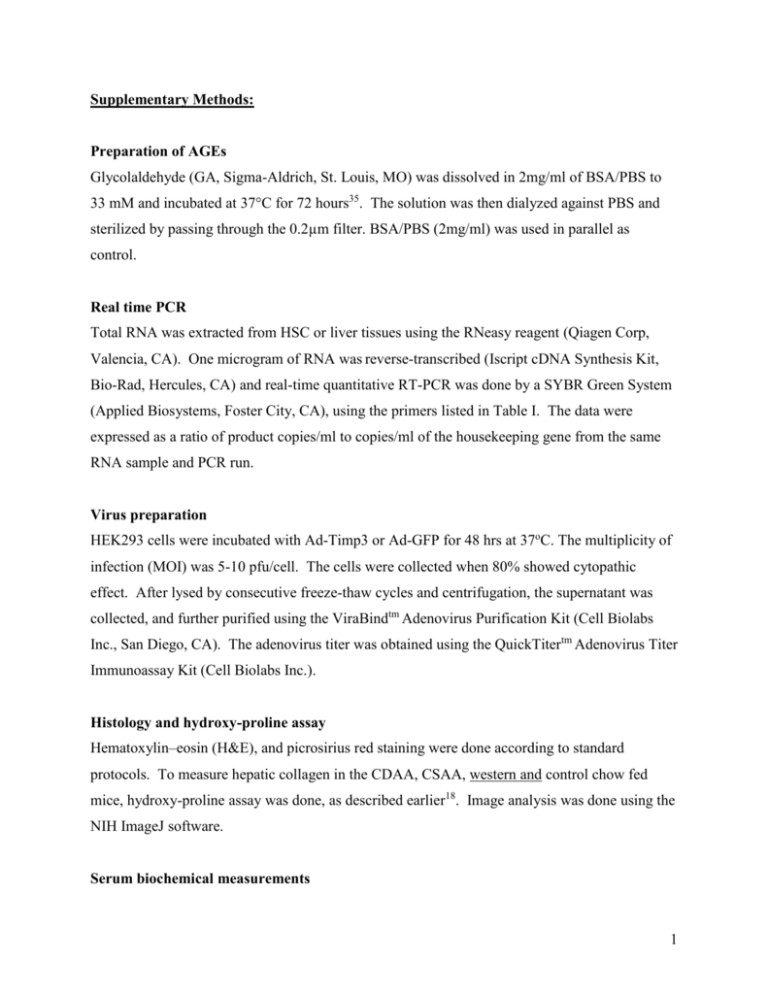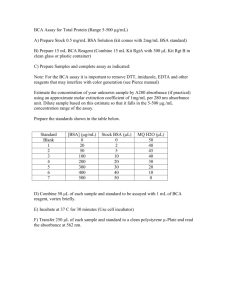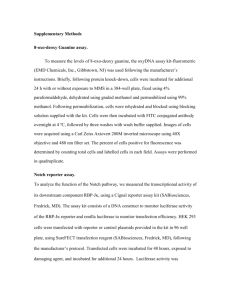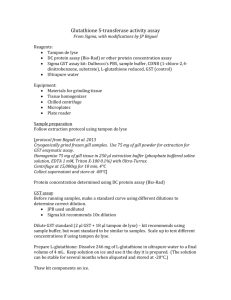hep26491-sup-0004-suppinfo
advertisement

Supplementary Methods: Preparation of AGEs Glycolaldehyde (GA, Sigma-Aldrich, St. Louis, MO) was dissolved in 2mg/ml of BSA/PBS to 33 mM and incubated at 37°C for 72 hours35. The solution was then dialyzed against PBS and sterilized by passing through the 0.2µm filter. BSA/PBS (2mg/ml) was used in parallel as control. Real time PCR Total RNA was extracted from HSC or liver tissues using the RNeasy reagent (Qiagen Corp, Valencia, CA). One microgram of RNA was reverse-transcribed (Iscript cDNA Synthesis Kit, Bio-Rad, Hercules, CA) and real-time quantitative RT-PCR was done by a SYBR Green System (Applied Biosystems, Foster City, CA), using the primers listed in Table I. The data were expressed as a ratio of product copies/ml to copies/ml of the housekeeping gene from the same RNA sample and PCR run. Virus preparation HEK293 cells were incubated with Ad-Timp3 or Ad-GFP for 48 hrs at 37oC. The multiplicity of infection (MOI) was 5-10 pfu/cell. The cells were collected when 80% showed cytopathic effect. After lysed by consecutive freeze-thaw cycles and centrifugation, the supernatant was collected, and further purified using the ViraBindtm Adenovirus Purification Kit (Cell Biolabs Inc., San Diego, CA). The adenovirus titer was obtained using the QuickTitertm Adenovirus Titer Immunoassay Kit (Cell Biolabs Inc.). Histology and hydroxy-proline assay Hematoxylin–eosin (H&E), and picrosirius red staining were done according to standard protocols. To measure hepatic collagen in the CDAA, CSAA, western and control chow fed mice, hydroxy-proline assay was done, as described earlier18. Image analysis was done using the NIH ImageJ software. Serum biochemical measurements 1 Serum ALT and bilirubin were assessed in mice on the different diets using kits following the manufacturer's instructions (BioVision Inc., Milpitas, CA). TACE Activity and TNFα ELISA TACE activity was determined using an assay kit (AnaSpec, San Jose, CA) according to the manufacturer's protocol. Twenty µg of protein from cell lysates or liver tissue homogenates were mixed with 40 μM of the fluorophoric QXL520/5FAM FRET substrate. Fluorescence of the cleavage product was measured with excitation 490nm/emission 520 nm representing the TACE activity. The liver TNFα levels were detected with an ELISA kit (Thermo Fisher Scientific, Waltham, MA) following standard protocols. TACE tyrosine phosphorylation Primary rat HSC were cultured in serum free medium for 16 hr, and treated with AGE or BSA for 1 hour. Cells were collected into a lysis buffer containing NaCl 137 mM, 10% glycerol, TrisHCl 20 mM, EDTA 2mM and 1% Triton X-100. The protein concentration was determined by a BCA assay kit (Thermo Fisher Scientific). Five hundred µg of protein was mixed with immobilized protein A agarose combined anti-TACE (Abcam, Cambridge, MA) rabbit antibody. The agarose resin was collected and washed with the lysis buffer, then resuspended into the sample buffer and boiled at 100ºC. The supernatant was separated with SDS-PAGE gel and transferred onto nitrocellulose membrane. The membranes were then blotted with antiphosphotyrosine antibody (Abcam), and also anti-TACE (Abcam). Lucigenin assay Lucigenin assay was performed on the livers of wt or NOX2-/- mice on CDAA, CSAA western or control chow diets. The membrane fraction was isolated by ultracentrifugation at 10,000xg, 30 min at 4ºC then incubated with lucigenin (5µM, Life Technologies, Grand Island, NY) at room temperature for 15 min. 100µM NADPH (Sigma-Aldrich) was then added and the lucigenin intensity was read by a luminometer every 1 min, up to 10 min. The data was adjusted to the protein amount. Statistics 2 All data represent at least three experiments and are expressed as the mean ±SE. Differences between groups were compared using ANOVA for repeated measures and the post-hoc Bonferroni test to correct for multiple comparisons. A p value of less than 0.05 was considered statistically significant. 3










![[supplementary informantion] New non](http://s3.studylib.net/store/data/007296005_1-28a4e2f21bf84c1941e2ba22e0c121c1-300x300.png)
